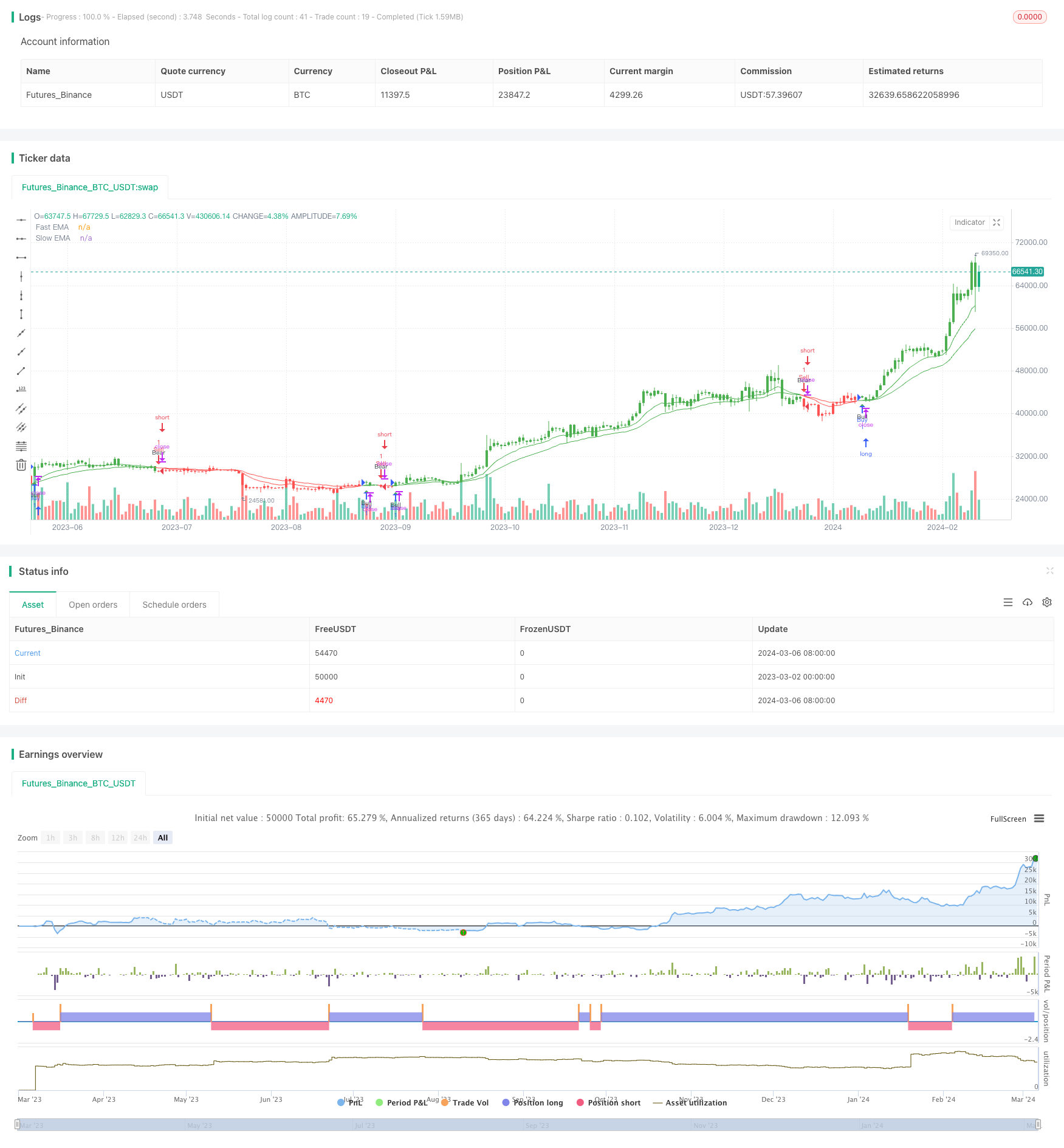基于EMA和随机RSI的多周期趋势跟踪交易策略
Author: ChaoZhang, Date: 2024-03-08 17:32:38Tags:

策略概述
该策略名为”基于EMA和随机RSI的多周期趋势跟踪交易策略”,利用两条不同周期的指数移动平均线(EMA)及随机RSI指标来捕捉市场的中长期趋势。策略的核心思想是通过EMA的交叉来判断趋势方向,同时结合随机RSI作为趋势确认和反转预警信号,以在趋势形成初期建仓,趋势末期平仓。
策略原理
计算快速EMA和慢速EMA。快速EMA默认参数为12,慢速EMA默认参数为25,实际应用中可以根据市场特性和交易频率进行调整。
判断多空趋势:
- 当快速EMA上穿慢速EMA时,产生看多信号
- 当快速EMA下穿慢速EMA时,产生看空信号
趋势确认:看多/看空信号出现后,需连续出现2根看多/看空K线才确认趋势形成。这有助于过滤掉假信号。
使用随机RSI作为辅助判断:
- 当随机RSI %K值上穿%D值,且%K值在20以下时,产生超卖信号,提示可能的上涨反转
- 当随机RSI %K值下穿%D值,且%K值在80以上时,产生超买信号,提示可能的下跌反转
- 交易策略:
- 当EMA产生看多信号,且随机RSI不处于超买区时,开多仓
- 当EMA产生看空信号,且随机RSI不处于超卖区时,开空仓
策略优势
同时使用两个不同周期的EMA,可以更好地平衡趋势捕捉的灵敏度和可靠性。分析表明12/25周期的EMA组合对中长期趋势把握较好。
趋势确认机制可以有效过滤掉大部分假信号,提高策略的胜率。
随机RSI作为辅助判断,在趋势初期帮助判断趋势强度,在趋势后期提前预警可能的趋势反转。
策略逻辑简单,参数较少,容易理解和实施,且适用于多种市场和品种。
风险分析
EMA为滞后指标,在趋势反转初期可能出现较大滑点。
趋势型策略在震荡市中表现一般。此策略缺乏对震荡市的专门判断。
随机RSI在市场剧烈波动时可能失真,影响判断质量。
固定参数可能无法适应所有市场状况,需要根据市场特点动态调整。
优化方向
引入ATR等波动率指标,根据波动率动态调整EMA参数,以适应不同的市场节奏。
增加对震荡市的判断,比如结合布林带开口方向等,避免在震荡市频繁交易。
在随机RSI基础上融入更多辅助判据,如成交量变化等,提高信号可靠度。
考虑市场关联性,引入多品种联动信号,增强系统抗风险能力。
总结
该策略充分利用了EMA和随机RSI的优势,形成了一套基于趋势跟踪和动量反转的中长期交易策略。通过均线交叉捕捉趋势,随机RSI确认趋势强度和预警反转,趋势确认机制提高信号质量,三者有机结合,形成了一个简单有效的量化交易策略框架。主要优势在于逻辑简洁,参数较少,实现难度低,适用范围广。同时策略也存在滑点较大,无法适应震荡市等固有局限性。未来可从动态参数优化,引入更多辅助判据,构建品种联动机制等方面深化和完善。总的来说,这是一个具有广阔优化空间和应用前景的量化交易策略。
/*backtest
start: 2023-03-02 00:00:00
end: 2024-03-07 00:00:00
period: 1d
basePeriod: 1h
exchanges: [{"eid":"Futures_Binance","currency":"BTC_USDT"}]
*/
//@version=5
strategy('[Jacky] Trader XO Macro Trend Scanner', overlay=true)
// Variables
var ok = 0
var countBuy = 0
var countSell = 0
src = input(close, title='OHLC Type')
i_fastEMA = input(12, title='Fast EMA')
i_slowEMA = input(25, title='Slow EMA')
i_defEMA = input(25, title='Consolidated EMA')
// Allow the option to show single or double EMA
i_bothEMAs = input(title='Show Both EMAs', defval=true)
// Define EMAs
v_fastEMA = ta.ema(src, i_fastEMA)
v_slowEMA = ta.ema(src, i_slowEMA)
v_biasEMA = ta.ema(src, i_defEMA)
// Color the EMAs
emaColor = v_fastEMA > v_slowEMA ? color.green : v_fastEMA < v_slowEMA ? color.red : #FF530D
// Plot EMAs
plot(i_bothEMAs ? na : v_biasEMA, color=emaColor, linewidth=3, title='Consolidated EMA')
plot(i_bothEMAs ? v_fastEMA : na, title='Fast EMA', color=emaColor)
plot(i_bothEMAs ? v_slowEMA : na, title='Slow EMA', color=emaColor)
// Colour the bars
buy = v_fastEMA > v_slowEMA
sell = v_fastEMA < v_slowEMA
if buy
countBuy += 1
countBuy
if buy
countSell := 0
countSell
if sell
countSell += 1
countSell
if sell
countBuy := 0
countBuy
buysignal = countBuy < 2 and countBuy > 0 and countSell < 1 and buy and not buy[1]
sellsignal = countSell > 0 and countSell < 2 and countBuy < 1 and sell and not sell[1]
barcolor(buysignal ? color.green : na)
barcolor(sellsignal ? color.red : na)
// Strategy backtest
if (buysignal)
strategy.entry("Buy", strategy.long)
if (sellsignal)
strategy.entry("Sell", strategy.short)
// Plot Bull/Bear
plotshape(buysignal, title='Bull', text='Bull', style=shape.triangleup, location=location.belowbar, color=color.new(color.green, 0), textcolor=color.new(color.black, 0), size=size.tiny)
plotshape(sellsignal, title='Bear', text='Bear', style=shape.triangledown, location=location.abovebar, color=color.new(color.red, 0), textcolor=color.new(color.black, 0), size=size.tiny)
bull = countBuy > 1
bear = countSell > 1
barcolor(bull ? color.green : na)
barcolor(bear ? color.red : na)
// Set Alerts
alertcondition(ta.crossover(v_fastEMA, v_slowEMA), title='Bullish EMA Cross', message='Bullish EMA crossover')
alertcondition(ta.crossunder(v_fastEMA, v_slowEMA), title='Bearish EMA Cross', message='Bearish EMA Crossover')
// Stoch RSI code
smoothK = input.int(3, 'K', minval=1)
smoothD = input.int(3, 'D', minval=1)
lengthRSI = input.int(14, 'RSI Length', minval=1)
lengthStoch = input.int(14, 'Stochastic Length', minval=1)
rsi1 = ta.rsi(src, lengthRSI)
k = ta.sma(ta.stoch(rsi1, rsi1, rsi1, lengthStoch), smoothK)
d = ta.sma(k, smoothD)
bandno0 = input.int(80, minval=1, title='Upper Band', group='Bands (change this instead of length in Style for Stoch RSI colour to work properly)')
bandno2 = input.int(50, minval=1, title='Middle Band', group='Bands (change this instead of length in Style for Stoch RSI colour to work properly)')
bandno1 = input.int(20, minval=1, title='Lower Band', group='Bands (change this instead of length in Style for Stoch RSI colour to work properly)')
// Alerts
crossoverAlertBgColourMidOnOff = input.bool(title='Crossover Alert Background Colour (Middle Level) [ON/OFF]', group='Crossover Alerts', defval=false)
crossoverAlertBgColourOBOSOnOff = input.bool(title='Crossover Alert Background Colour (OB/OS Level) [ON/OFF]', group='Crossover Alerts', defval=false)
crossoverAlertBgColourGreaterThanOnOff = input.bool(title='Crossover Alert >input [ON/OFF]', group='Crossover Alerts', defval=false)
crossoverAlertBgColourLessThanOnOff = input.bool(title='Crossover Alert <input [ON/OFF]', group='Crossover Alerts', defval=false)
maTypeChoice = input.string('EMA', title='MA Type', group='Moving Average', options=['EMA', 'WMA', 'SMA', 'None'])
maSrc = input.source(close, title='MA Source', group='Moving Average')
maLen = input.int(200, minval=1, title='MA Length', group='Moving Average')
maValue = if maTypeChoice == 'EMA'
ta.ema(maSrc, maLen)
else if maTypeChoice == 'WMA'
ta.wma(maSrc, maLen)
else if maTypeChoice == 'SMA'
ta.sma(maSrc, maLen)
else
0
crossupCHECK = maTypeChoice == 'None' or open > maValue and maTypeChoice != 'None'
crossdownCHECK = maTypeChoice == 'None' or open < maValue and maTypeChoice != 'None'
crossupalert = crossupCHECK and ta.crossover(k, d) and (k < bandno2 or d < bandno2)
crossdownalert = crossdownCHECK and ta.crossunder(k, d) and (k > bandno2 or d > bandno2)
crossupOSalert = crossupCHECK and ta.crossover(k, d) and (k < bandno1 or d < bandno1)
crossdownOBalert = crossdownCHECK and ta.crossunder(k, d) and (k > bandno0 or d > bandno0)
aboveBandalert = ta.crossunder(k, bandno0)
belowBandalert = ta.crossover(k, bandno1)
bgcolor(color=crossupalert and crossoverAlertBgColourMidOnOff ? #4CAF50 : crossdownalert and crossoverAlertBgColourMidOnOff ? #FF0000 : na, title='Crossover Alert Background Colour (Middle Level)', transp=70)
bgcolor(color=crossupOSalert and crossoverAlertBgColourOBOSOnOff ? #fbc02d : crossdownOBalert and crossoverAlertBgColourOBOSOnOff ? #000000 : na, title='Crossover Alert Background Colour (OB/OS Level)', transp=70)
bgcolor(color=aboveBandalert and crossoverAlertBgColourGreaterThanOnOff ? #ff0014 : crossdownalert and crossoverAlertBgColourMidOnOff ? #FF0000 : na, title='Crossover Alert - K > Upper level', transp=70)
bgcolor(color=belowBandalert and crossoverAlertBgColourLessThanOnOff ? #4CAF50 : crossdownalert and crossoverAlertBgColourMidOnOff ? #FF0000 : na, title='Crossover Alert - K < Lower level', transp=70)
alertcondition(crossupalert or crossdownalert, title='Stoch RSI Crossover', message='STOCH RSI CROSSOVER')
- 基于平均价海金阿什烛台与相对强弱指数的动态调仓策略
- 均线与超级趋势结合的日内多空动态平衡策略
- 基于超级趋势和MACD的风险控制策略
- 基于UT Bot指标的ATR移动止损策略
- G-Channel与EMA结合的趋势跟踪策略
- 布林带与移动平均线结合的相对强弱指标交易策略
- 基于动量顺势策略
- 基于随机力矩指标的量化交易策略
- 基于支撑阻力和动量指标的多时间框架趋势跟踪策略
- 基于VWAP和跨周期信号的多空动态止盈止损策略
- 基于价格波动范围的买卖信号过滤策略
- 连续阴跌-阳涨反转策略
- 抛物线SAR趋势跟踪策略 6.0
- 布林带与随机指标KD交叉策略
- 基于随机RSI和EMA交叉的加密货币回调交易策略
- 基于VWAP和OBV RSI指标的BabyShark交易策略
- 比特币动量跟踪止损策略
- 基于多阶段布林带和MACD指标的量化交易策略
- MACD均线多头量化交易策略
- 甲易炳量化趋势动量交易策略